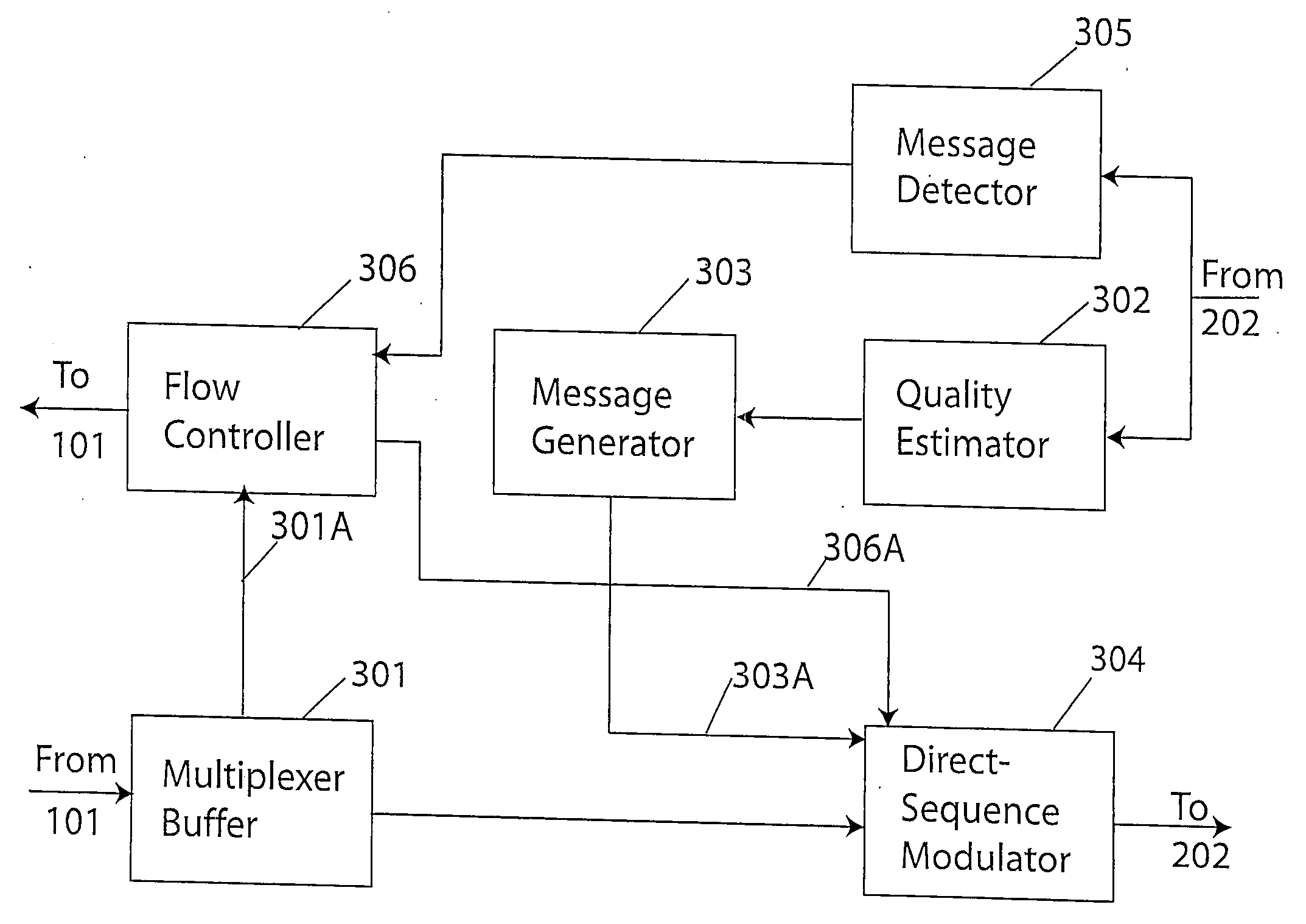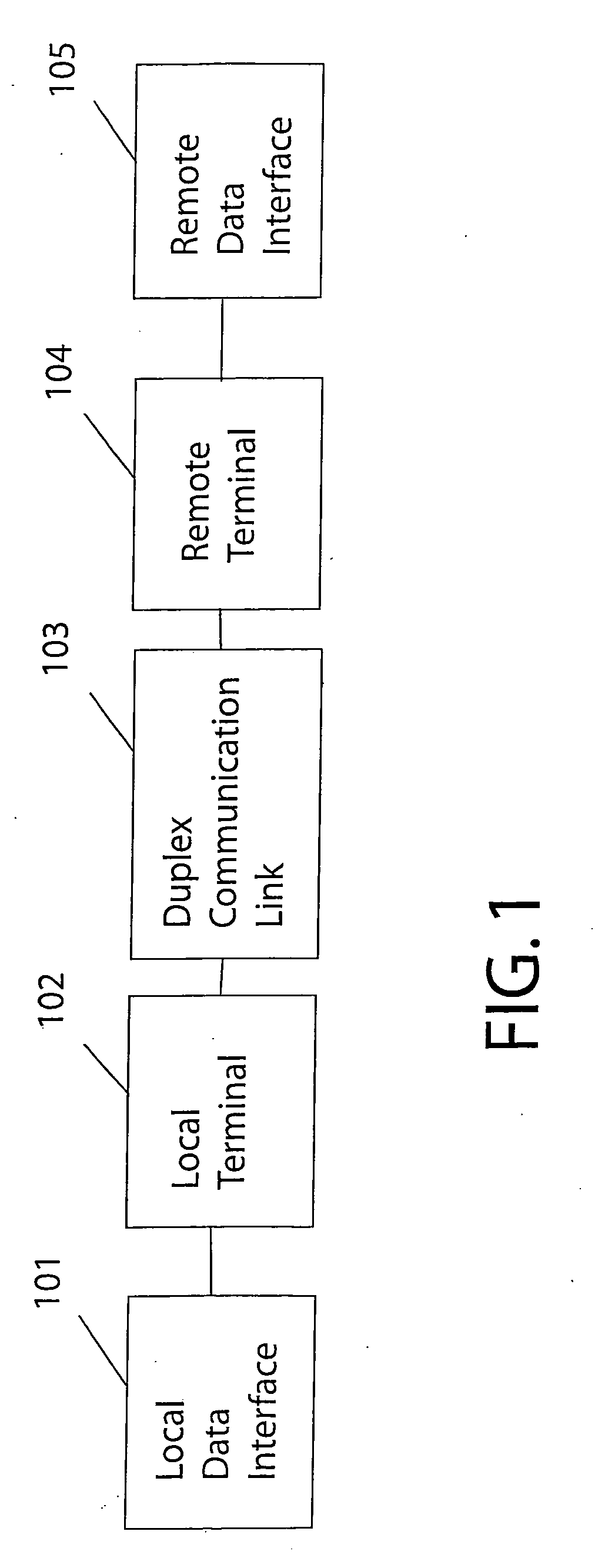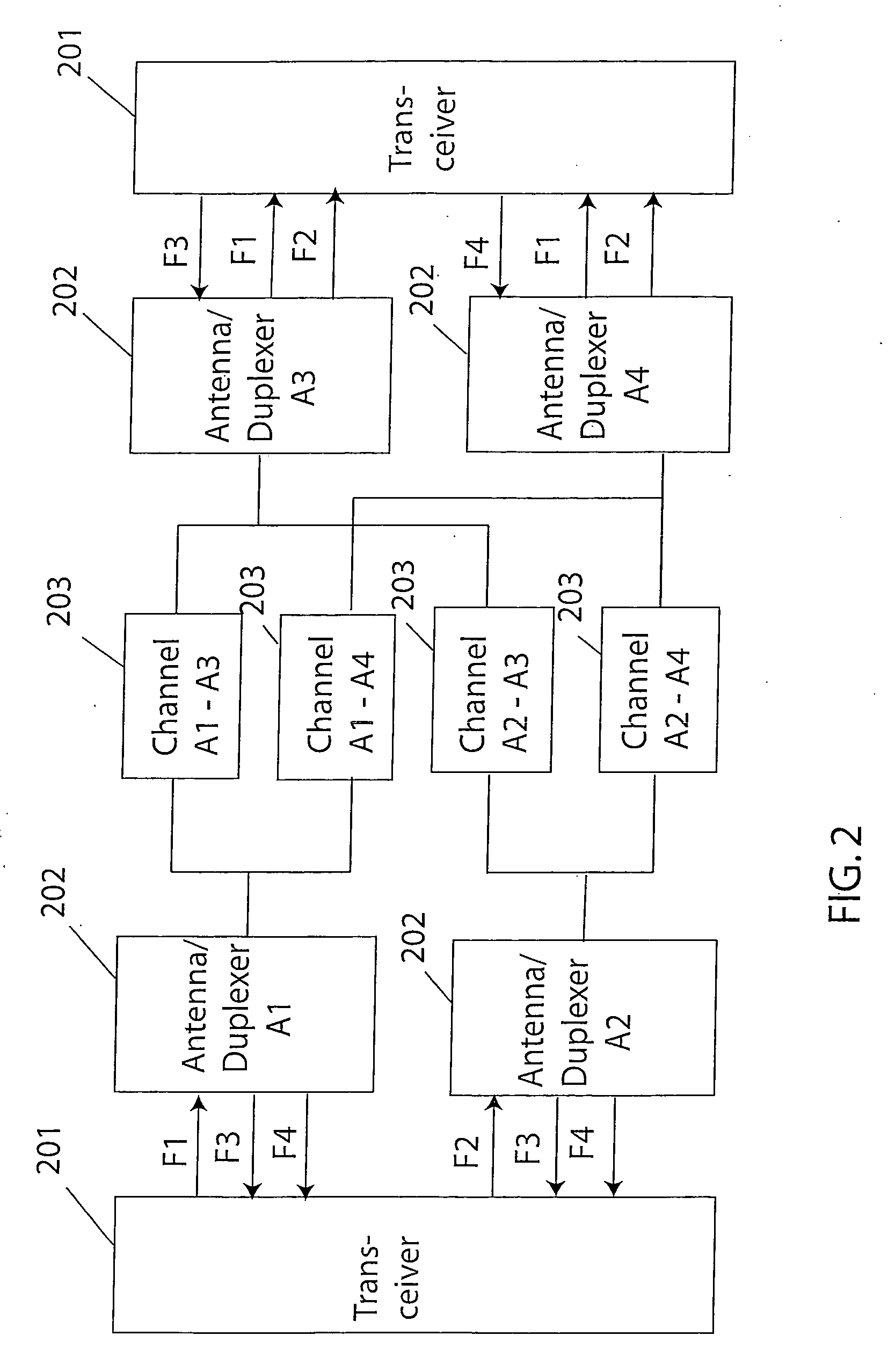[0026] It is the objective of the present invention to develop an adaptive data rate technique for a duplex radio link that will
exploit improved transmission conditions through a combination of
quality assessment of channel conditions, feedback communications, efficient utilization of diversity channels, and
digital data flow control. It is also an objective of the present invention to develop a practical feedback communication technique that operates nearly as well as the zero
delay, perfectly reliable, theoretical ideal feedback communications technique. It is the further objective of this invention to significantly increase the data
throughput of IP traffic over a period of time including both short and long term
fading effects.
[0027] Although the techniques in the present invention may be applied to any duplex link containing fading dispersive channels, the invention advantages are most easily illustrated in a tropospheric scatter application. Tropospheric scatter systems are power limited and the long distance character of these systems produces both short and long term signal variations each with
large dynamic range. These systems also transmit high enough data rates, on the order of 10 Mb / s, so that the overhead associated with feedback communication is small.
[0028] In troposcatter systems the fading is due to forward scattering of the signal within a common volume defined by the
scattering parameters and common antenna beam region. Because the scattering occurs at very small angles, there is little transfer of energy from one orthogonal polarization to another. This preservation of polarization orthogonality in a fading environment is a particular characteristic of tropospheric scatter and does not occur in other fading environments such as mobile cellular where large angle reflections occur. Since polarization orthogonality is preserved in troposcatter systems, it should be possible to approximately double the data rate by transmitting
independent data on each of the orthogonal polarizations. This is not currently done in present troposcatter systems because orthogonal polarization is used to separate different spatial paths between antennas in order to maximize the diversity order. It is an object of this invention to utilize orthogonal polarizations for transmission of
independent data and with
adaptation of the data rate provide higher median data rate than present systems under the same
signal strength conditions. It is a further objective of this invention to develop a Multiple-Input Multiple Output (
MIMO)
equalizer that will further increase achievable data rate by allowing the transmission of independent data from
multiple antenna ports within the same
frequency band and on the same polarization.
[0031] In the preferred embodiment the link
quality measurement is accomplished by correlating reference data and the received signal associated with a fading dispersive channel to provide channel estimates of multipath components. The sum of the magnitude-squared channel estimates appropriately normalized by the additive
noise level is a quality measure of the associated fading dispersive channel because it represents the total signal-to-
noise ratio. Even when there is a large amount of multipath, DFE technology such as described in Adaptive
Equalization can efficiently
exploit virtually all the multipath components with small ISI penalty so that total received signal energy can be used as a quality component. The resulting link quality measure is converted into a feedback message that is transmitted along with the coded / interleaved digital
data information.
[0032] In addition to transmission of digital
data information, reference data for aid in
receiver processing is also transmitted. Transmitted reference data is known at the receiver so that at the receiver it can be generated for receiver
processing. In a preferred embodiment feedback messages are transmitted by replacing modulation symbols that are associated with reference data. In the present invention
transmit diversity channels that are orthogonal or almost orthogonal each contain independent digital data transmitted with a selected data rate mode. Receive diversities in the present invention are combined and the effect of this combination is included in the data
rate adaptation. While the use of orthogonal transit diversity channels result in an additive increase in capacity as shown above, capacity can also be increased in a Multiple-Input Multiple-Output (
MIMO)
system by transmitting independent data on transmit diversity channels that share the same
frequency band and
orthogonalization. A modification to the
high data rate channel-estimating DFE described in Adaptive
Equalization is developed herein for this MIMO application. The MIMO DFE additionally mitigates the mutual interference produced by the multipath when independent data is sent on nonorthogonal, i.e. MIMO, transmit diversity channels.
[0033] The reference data and digital
data information are modulated in accordance with a selected data rate mode that is a function of direct sequence spreading
gain, N, error
correction code rate, rc, and signal
constellation size, M. In a preferred embodiment reference data is time-division multiplexed with digital data information after it has been error-corrected coded and interleaved. The resulting modulation symbols depend on the signal
constellation type, e.g. for Quadrature-Phase-Shift
Keying (QPSK) the symbol set is exp(jπn / 2+jπ / 4), n=0,1,2,3. The modulation symbols are then multiplied by a direct-sequence spreading pattern to produce symbols for transmission. The transmitted signal uses the same
symbol rate (1 / T) for all data rate
modes so as to maintain a constant bandwidth and to facilitate receiver
processing. For lower data rate
modes where N>1, the symbol corresponds to a
chip symbol such that there are N
chip symbols per modulation symbol. In these
modes the constellation type corresponds to QPSK (also called MPSK with M=4). In higher data rate modes where N=1, i.e. there is no direct-sequence
spread spectrum gain, there are log2M coded bits per modulation symbol and this is also the symbol to be transmitted. With the peak power constraint of nonlinear amplifiers the selected modulation is MPSK for M=4 and 8 and M-ary
Quadrature Amplitude Modulation (MQAM) for M≧16.
 Login to View More
Login to View More  Login to View More
Login to View More 


